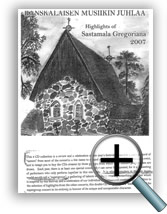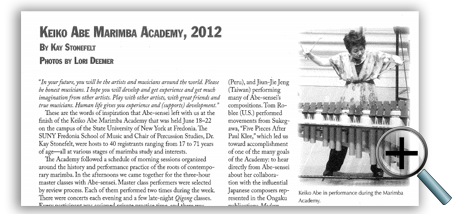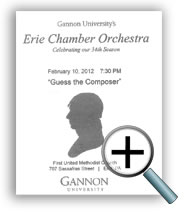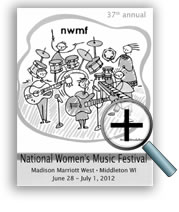8 - The State University of New York at Fredonia, Professor of Music, Chair of Percussion Studies
Career Phase Five (1994 - 2014)
In the spring of 1989, I was fortunate to serve as a Lecturer at The State University of New York at Fredonia as a one-semester sabbatical replacement for my predecessor, Ted Frazeur. Even though I was familiar with the positive image of the Fredonia School of Music (I had grown up in New Jersey and knew of music at Fredonia), it was during that particular semester that I became acquainted with the full spectrum of possibilities in such an academic and musical environment. Later, when I was contacted about the tenure track position in Percussion Studies I was very excited about returning to the Fredonia environment. I accepted the position of Associate Professor of Music, Percussion, to begin in August 1993. At the same time, I was awarded a Fulbright Senior Scholar Research opportunity and was therefore on leave from Fredonia during my first academic year of 1993-94.
World Music Development:
African Music Ensembles
My Fulbright experience enabled me to begin at Fredonia with fresh ideas, contacts, and information that continue to grow in quality and consistency. My objective was to establish not only sustainable African Xylophone and Drumming Ensembles but also to create an awareness and understanding of the historical and cultural contexts from which these practices originate. I was then and am now dedicated to sharing this knowledge, especially to including people from the cultures in the teaching of these concepts. The collaboration between interpreter (Stonefelt as ethnomusicologist) and someone from the culture under study is what makes our program strong, unique, and sustainable. A developmental description of the ensembles on our campus follows.
The Fredonia African Xylophone and Drumming Ensembles were founded in 1994 by Dr. Kay Stonefelt as a direct result of her Fulbright Senior Scholar Research award to study music, theatre and dance in Ghana (1993-1994), and her musical training in these areas in NYC (drumming) and at Indiana University (amadinda – log xylophone of Uganda). To further infuse the Fredonia African performance groups with energy, cultural, and contextual relevance, Kay and Fredonia Dance Professor Carol Prevet co-wrote, and were awarded, a Fulbright Visiting Scholar research proposal that supported the one-year Fredonia campus residency of master drummer and dancer Francis Kofi.
Support from the Dr. Richard Lundquist award for travel to third world countries and our International Studies program enables several members of the ensembles to travel to Ghana for a minimum of an eight week stay to further their music and cultural studies: Fredonia students Christopher Jaquin, Nichole Bailey, Dan Schubmehl, Christine Merges, Michelle Dierlein, and Katherine Pertersen received awards to study in Ghana.
The following Ghanaian performing artists have accomplished influential and additional residencies on our campus: Lizzy Hammond (Akan culture - Ghana), Francis Kofi (Ewe culture - Togo and Ghana), Bernard Woma (Dagara culture - Ghana), and Grace Djabatey (Ga culture – Ghana), The Saakumu Dance Troupe (represents all cultures of Ghana).
The Fredonia African music ensembles serve a wide segment of the campus, local, national, and international communities by performing at ceremonial and recreational events, presenting workshops and performances for local and international conferences, and through appearances in numerous public schools for assemblies, workshops, and cultural presentations.
Not only does this program have an impact on our campus, it has a far-reaching and sustainable impact throughout the world. At least six graduates of the Fredonia Percussion Studio have enhanced their Graduate Assistantship potential through their exposure to this program by accompanying dance classes or by starting African performance ensembles in their graduate programs. They have developed professional careers in the area of dance accompaniment. All of the Music Education percussion graduates are using these skills in their teaching programs in one way or another. From 1994 through 2009, both Dr. Stonefelt and Mr. Woma traveled nationally and internationally to colleges, universities, public schools, and performance venues, always with the name of Fredonia at our side.
| Tracks from "The Flow of Time" | |
| Track 01 Mumula Saabir | |
| Track 08 VaaIr Zore | |
| Track 10 Nir Baa Nong Me | |
Mexican Marimba & World Mallets Ensembles
Through the granting process and administrative support, our World Music Program (Mexican Marimba, balafon, and most recently, gamelan) has continued to develop. We have been supported yearly through the Carnahan-Jackson Fund for the Humanities, the School of Music, Women’s History Month projects, and such Student Association Groups as the Percussion Guild and Black Student Union.
Together with Adjunct Lecturer in Percussion Studies, Tiffany Nicely (an expert in Mexican Marimba & balafon styles), we devised a program that includes all freshmen and sophomore level percussion students. This program addresses sight reading, chord structure, improvisation, and rhythmic structure, all elements of music that are most often left out of a young drummer’s training and background.
I believe that it was my training, professional experience, and vision for the development of sustainable world music on campus that has enabled the above ensembles to grow and continue to flourish under the current and excellent direction of Tiffany Nicely.
Gamelan, Bali
In the spring of 2013, the Percussion Guild was able to access funds that enabled us to acquire a basic gamelan ensemble. The students learned a lot about how to import instruments from overseas, taxes, ports of entry, clearing agents, and trucking! While the instruments were in transit, I took a summer course in gamelan at the Eastman School of Music. Through this course, l was able to identify a very able and experienced instructor who comes to the Fredonia campus once every two weeks to instruct us. I go to this class with the students and we also practice during the in-between weeks. The funding for this instruction comes through the Student Association Percussion Guild budget. Participation is open to the entire campus community.
Arabic Music
Arabic Music was the topic for the 2014 Music Academy Week at Fredonia. I identified George Dimitri Sawa (arguably the leading scholar in this field) as the featured lecturer and performing artist for this Academy. Participants came from 4 states and Canada and they varied from Deanship position to professional performers to many Fredonia students. We incorporated the Middle East art, photography, and artifact collection (1966-1982) of local resident Penny Williams Yaqub into this event.
Music from Japan
Past Academy Weeks (2012 & 2013) have featured Keiko Abe, marimba artist, specialist in contemporary music from Japan. These Academies drew over 60 participants from Mainland China, Taiwan, Japan, Peru, Fredonia students, and students of all levels from various locations in the US.
These international events bring the world to Fredonia but they also help to bring our students and community closer to the world.
Summer Graduate Course
In addition to the undergraduate offerings in African performance, Kay Stonefelt and Bernard Woma devised a summer graduate course, “African Music and Movement.” This course includes discussion and topics relating to the “STANDARDS” that are required at every grade level in New York. We have taught this course at The State University of New York at Fredonia and at Indiana University.
Western Percussion:
In my opinion, the far-reaching and sustainable effects of the above course and ensemble work could not take place and would not be as effective were it not for our solid studio performance requirements and results in Western percussion techniques and repertoire. I constantly question how I learned and when I learned. What was required of a student in my time and what is required of a student now. In my lifetime I have studied with the leading pedagogues in the field of Western percussion. I have taught in highly respected institutions and performed in some of the most respected venues and concerts halls in the world (Carnegie Hall, Avery Fischer Hall, Severence Hall, the Bolshoi and Kirov Theatres, many Broadway Theatres, The World Trade Center, etc.).
Because of my life experiences and continuing curiosity, I know what a young student must accomplish in four years of undergraduate study to become and to remain competitive in the area of percussion. In the past 20 years at Fredonia I have revised and refined my approach to sharing this information with our students. I focus on technique and the music, but also on the life skills and social interactions that are necessary for survival in the working world. I allow students to walk several paths, to make choices, and for them to place priorities. I discuss the possibilities and responsibilities of their career paths and actions and try not to be judgmental about their decisions and actions unless they are repeatedly damaging to the wellbeing of our programs or other students. I do take steps to remedy negative behavior.
Curricular Development
In order to share the most information with the most students I reorganized many of the percussion studio lessons to include small marimba group formats for freshmen and sophomores. I did this to address the weak backgrounds that most of them have at entrance level when it comes to the understanding of the theory and structure of Western music and the technical approach to performing on the mallet instruments. Those students that are more advanced at entrance also benefit from being in a group of advanced players. Initially, the groups were of 2 or 3 people with like abilities and standing in the college program. We met two times in a week for ½ hour each time. Formerly, a music education person would only have one fifty-minute lesson a week. Now these groups of two music education people would meet for 2 thirty-minute sessions a week and a ½ hour private session each, thereby learning from each other and also receiving private lesson time. In the process of the groups, they learned valuable pedagogical techniques. In addition, students were less likely to “put off” practicing as they met more often and at closer intervals of time.
This concept and format has been incorporated into the Mexican Marimba Ensemble classes. The students are attracted to the style of the music and they can relate to the structures more easily than many contemporary styles. The format enables more constant reinforcement of technical material, group sight reading, and repertoire, and insures that the students play through these materials at least two times a week. Each session is divided into sections, devoting time to improvisation, sight reading, technical material, and prepared pieces. While the frequency of practice should not be an issue and we give clear instructions on how to practice and the expected length of time, it has been my observation that many of our students do 1 or 2 practice sessions a week for short periods of time and they think that they are doing the maximum that they can under the pressures of their individual programs.
I know that many leading artists prefer to teach in master class group sessions. Leon Fleischer, for one, has his students all come to each other’s lessons. They then mark in the fingerings, phrasing, etc. that he discusses with the performing student. When it is another’s turn to perform that piece, they are familiar with the piece and the groundwork has been done. In the same way, my students, through these group settings and the Recital Seminar classes, are exposed to many more pieces of music and the various aspects of their performance, both technical and musical. While the students may not all perform these pieces right away, it is part of their basic education to be familiar with them. Additionally, the students are able to perform their pieces in a supportive environment of the group, thereby preparing themselves for public performance in a less threatening manner.
The improvisational ideas came from workshops that I took with David Darling (Music for People) in 1996 and the summer of 1999, and from several training classes with Michael Colgrass who incorporates Neural Linguistic Programming techniques in his work. In the fall of 1999 through spring of 2000, in conjunction with David Rudge, we devised a trial course in Improvisation, incorporating voice, rhythm, and instrumental improvisation based on the concepts of David Darling and Michael Colgrass. Reading assignments included “Zen in the Art of Archery,” by Herrigel, “Free Play,” by Nachmanovitch, and “Lessons of the Lotus,” by Bhante Wimala. The following years I have kept these principals in the percussion studio and group sessions.
In the summer of 1999, I had the opportunity to observe some of the successful examples of learning used at the Transcendental Meditation Group’s elementary, middle, and high schools in Fairfield, Iowa. Every year the state of Iowa finishes at or near the top of the USA standards for one of the best states to educate a child. The Transcendental Meditation students and schools are at the top in the state of Iowa. I asked and observed how this is accomplished. Their emphasis is on small groups and intense focus on one subject at a time with frequent meetings. I thought about how this could apply to percussion and decided to form the groups according to topic need and like ability.
The focus was different for each of the groups but the results were impressive. For instance, due to lack of background, many percussionists have a problem with pitch perception and that presents serious problems in timpani tuning. Individually, students struggle along and don’t seem to develop a sense of correct or incorrect tuning. Working in the groups for two semesters, many students were able to make confident progress while others became aware of ideas and methods to help with their progress. I never felt that any of them were intimidated or pressured because we were able to let up and move from the intensity of the tuning to other issues of timpani performance within the group, and to build on the freshman and sophomore levels of materials that covered tonal orientation and spatial technique at the mallet instruments.
I had studied timpani pedal technique with George Gaber, timpanist for the NBC Orchestra under Toscanini. Gaber’s approach to work in the area of pedal timpani and pitch perception involved intense ear training but also that of muscle memory as it relates to concepts of foot movement in space. I took Gaber’s ideas a little farther in that we worked to relate the concept of arm and hand movement in space when striking the desired keys of a mallet instrument (an observable and tangible pitch result) to foot on timpani pedal movement to achieve the desired pitches (in this case more than a bit elusive but for the memorization of how far the pedal moves in space). When I introduced this material we started the school year off with very few capable timpanists and at the end of the year we finished with several timpanists who played with confidence.
About every third year we include comprehensive drum set sessions for every student in the studio. The groups are arranged by ability only and do not consider class standing. The groups also include recitalists who normally would only receive private sessions on their recital material.
My personal evaluation of the progress of the studio is that the basic skills, technical materials, sight reading abilities, and repertoire covered by the freshmen and sophomores in these groups brings them to a level that once took until the completion of the junior year to accomplish, which, in my opinion, was unacceptable for performance majors, and only borderline acceptable in standard to be graduated as percussion specialist in music education. A combination of group and private sessions seems to be necessary and efficient.
An enormous amount of time is required to organize large numbers of students for like ability, class standing, teacher availability, room availability, and student schedules.
Adjunct Percussion Faculty and the Curriculum
In addition to all of the logistics, our approach requires good cooperation between the studio teachers. Each of the adjunct percussion teachers has their own specialty in addition to a well-rounded
Western percussion background. John Bacon is an internationally acknowledged specialist in traditional and modern jazz drum set techniques as well as in traditional Latin and Latin Jazz Ensembles, all of which he teaches at Fredonia. He is a published composer and recording artist and he teaches all of the Percussion Methods classes at Fredonia.
Tiffany Nicely is an accomplished musician in Western percussion performance, composition and theory, and she is a specialist in African Drumming and Mallet instruments, and Mexican Marimba Ensemble music. She studied Mexican marimba style with Steve Chavez at the University of New Mexico and has done further study and research in literature and techniques of performance and playing in Chiapas, Mexico. She shares her expertise with members of the Fredonia Percussion
Ensemble and as the nucleus, they, as well as the Balafon,* Gyil,* and Amadinda* Ensembles, present a World Mallet Concert each semester.
* variously constructed xylophone instruments of Africa.
In recognition of our American jazz art form, and the influence and impact it has had in all aspects of current musical thought, I invited David Kayne, jazz vibraphone artist to join our percussion adjunct faculty in the fall of 2004. In the fall of 2005, Fredonia witnessed a jazz vibraphone recital, that of Debra Lippa, Master of Music, performance degree program. To my knowledge this was the first all-jazz student curricular recital on the Fredonia campus. Now it is possible for several students a semester to study privately with David Kayne and for them to follow an intensive and highly structured program in vibraphone performance that incorporates the language, improvisation, and theory of jazz music.
Current Performance and
Summation
Since my beginning at Fredonia, the undergraduate Percussion Studio has grown from eight students a semester to an average of 34 – 36; whereas there were no graduate students for several years, we now have an average of two - four each semester. To accommodate our growth, the percussion faculty has grown from one full time tenured position to one full time and three adjunct positions, each with a specialty to offer.
Through my efforts, and with administrative and donor support, there is an endowed undergraduate percussion scholarship and a scholarship specifically for graduate percussion support, the first graduate scholarship for performance in the School of Music.
When I arrived at Fredonia, there was a yearly donation of $250 made to the Fredonia Foundation to be used as a Percussion Studio Award in the name of my predecessor, Professor Theodore Frazeur. The Frazeur award continued in that manner until I put in process a homecoming event (2010) that would honor Prof. Frazeur and Professor Robert Schweik (English). I coordinated with the Alumni Affairs Office, Fredonia Foundation, and Malcolm Nelson and Adrienne McCormick in English to produce a performance of the Frazeur (music) / Joanne Schweik (poetry) composition, “The ABC Adventure" (letter of invitation).
This event entailed raising funds to bring together a professional chamber orchestra (WNYCO) for rehearsals and performance with Frazeur conducting and his daughter, a professional actress, Gisele Frazeur, as narrator/actress. Through the Alumni Affairs Office, we did a large mailing to contact Percussion Studio alumni of mine and those of Professor Frazeur. The response was surprisingly good and a group of alumni and then-current percussion students performed several works of Professor Frazeur and some landmark pieces. My goal from this event was to endow the scholarship in Professor Frazeur’s name and we did so within one year’s time.
From the energy of the above event, one of Professor Frazeur’s students, who graduated in 1966, stepped forward to assist in the final steps of endowment and also established the Christian R. Granger Graduate Percussion Scholarship.
From these events and the support of many alumni and the School of Music, I have been able to garner support for a quarter-time and a half-time graduate assistantship. These assistantships give valuable training to those who hold them. The graduate students teach with supervision and support from me, they conduct the percussion ensemble, and they learn valuable information about the care and repair of percussion equipment. The students in turn help me with the maintenance and inventory of 650 pieces of equipment.
I have overseen the growth of percussion inventory through several renovation cycles. I arrived at Fredonia to find a rather bare bones percussion inventory. Since that time I have directed the acquisition of approximately $80,000 worth of state-of-the-art equipment. With help from the graduate assistant, I track and maintain an inventory of approximately 650 pieces of percussion equipment.
I regularly perform in orchestras as a percussionist, timpanist, and sometimes as a soloist.
My interest in Medieval and Renaissance music continues as I perform in the USA and Finland with Fioretto Ensemble.
  |
I play drum set in musicals, small jazz ensembles, and in contemporary compositions.
I continue working with contemporary composers and recording such mallet pieces as “Time’s Racing: but measured by what we do,” dedicated to me by composer Eric Richards.
I perform regularly on School of Music Faculty Recital Night and endeavor to bring new works and diversity of programming to our student population.
I remain active in the Women’s Music Community.
I conduct the Fredonia Percussion Ensemble in one concert each semester. We do guest performances in NY State and surrounding areas of Pennsylvania. I conduct chamber music ensembles for various events, such as our new music group – Ethos, or with special guests such as Arturo Sandoval.
Through knowledge gained in professional contacts and academic associations, continuing work in performance, work on the Percussive Arts Society Board of Directors, and as a former member of the Education Committee of the Society for Ethnomusicology, I can say without reservation that the Fredonia Percussion Studio is second to none in the outcome of our students lives and careers, the programs that we offer, and the opportunities that exist for our students. We have a strong central core of Western percussion and offer enough flexibility and diversity around the program for even the most advanced students to be challenged within the degree programs that we offer.


